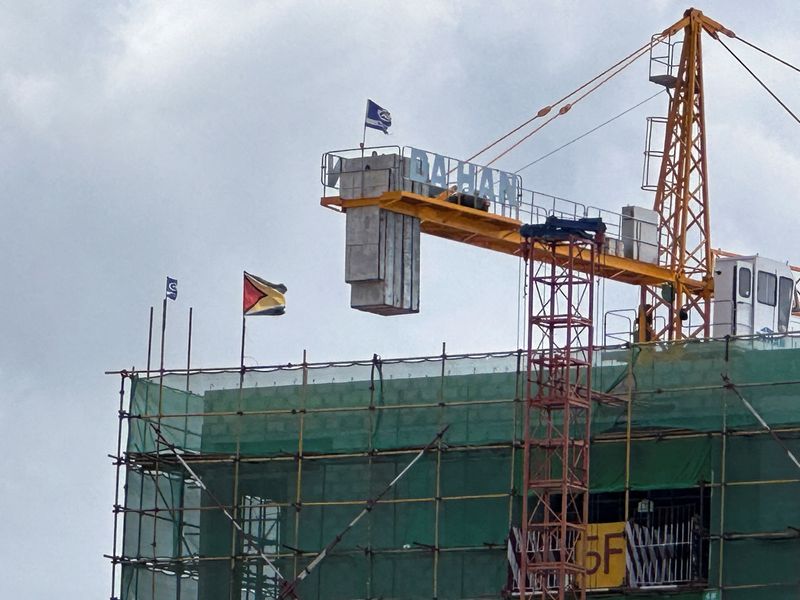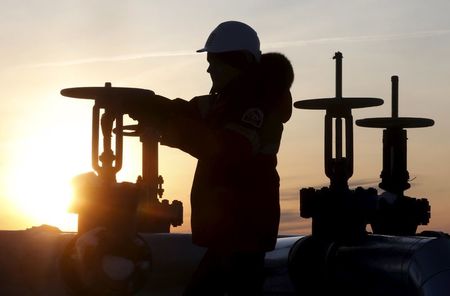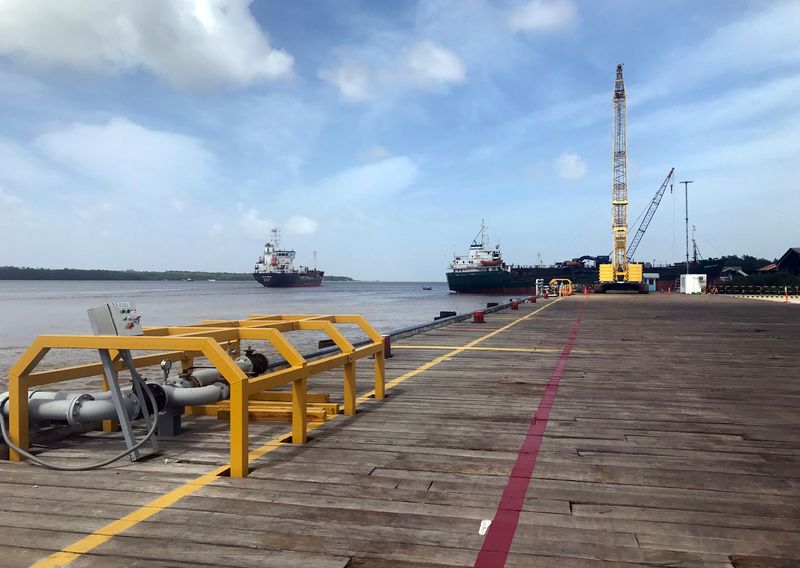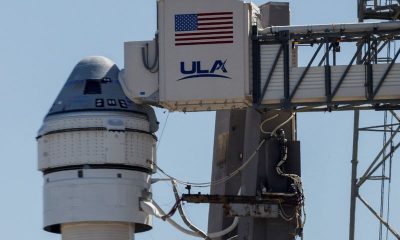Commodities
Guyana gas-to-power project to shave weeks off oil output, hit revenue

By Sabrina Valle
GEORGETOWN (Reuters) – Guyana’s efforts to use its resources to fuel a power plant that would slash the South American nation’s energy costs have snagged on construction delays and threaten to curtail the rising oil hotspot’s revenue this year by about $1 billion.
The $1.9 billion gas-to-power project, Guyana’s biggest effort to capitalize on its energy bounty, is embroiled in legal fights and risks cost overruns. The first phase of a 300-megawatt (MW) power plant is running six months behind schedule and full operation is not expected until the fourth quarter of 2025, officials have said.
Exxon Mobil (NYSE:), which operates all the oil and gas production in Guyana, is building a 140-mile (225-km) gas pipeline from its offshore Stabroek block to supply the government’s project onshore: a power plant, a related natural gas processing facility and transmission lines.
The U.S. oil major’s part of the project, the about $1 billion pipeline, will be ready by year-end as promised to Guyana, said Exxon Guyana country manager Alistair Routledge. That is despite having nothing to connect it to onshore because of delays on the works managed by the government.
The Stabroek block, site of the country’s first commercial oil and gas discovery in 2015, currently produces crude – about 645,000 barrels per day (bpd). The new power plant will be the first to use the associated gas produced from the oil field that to date has been re-injected underground.
The gas pipeline completion will require Exxon to pause production in the third quarter at two oil production vessels to connect them to the undersea pipeline, Routledge said.
If the tie-in lasts four weeks, Exxon and its consortium partners Hess (NYSE:) and China’s CNOOC (NYSE:) would have to halt up to 12 million barrels of oil output from two platforms that produce 400,000 bpd at peak levels.
Based on Guyana’s recent sale at $85 per barrel, that could mean over $1 billion in deferred oil revenue.
An Exxon spokesperson last week declined to specify how long the production halt will last. Routledge had said the pipeline connection and maintenance works would take “weeks, not months.”
The executive said Exxon is not worried about having to shut production this year for a project that will not be ready to accept the gas at least until sometime in 2025.
When the gas-fired power plant is ready is “a question of timing,” said Routledge.
“It’s hard to have all the facilities ready at the same time.” As soon as the onshore facilities are ready, “the whole thing will start up and all those benefits will flow to the country,” he said.
Guyana will miss the chance to slash its power costs this year because of the project delay. It imports expensive fuel oil for an aged and often faulty power facility. When fully running on natural gas, the new plant will reduce the nation’s power costs by 50%, officials have said.
“Of course we are doing the best we can, but we have to be realistic,” Winston Brassington, who coordinates the power project as a consultant for Guyana’s Ministry of Natural Resources, said in an interview in February.
While it is not uncommon for major projects to run behind schedule, Guyana’s government faces a presidential and parliamentary election next year and is keen to deliver tangible benefits to the nation’s 750,000 residents.
“There is more pavement in the city,” says fruit vendor Michael Bharrat, 23, when asked about the most visible signs of development brought by the nation’s oil boom. “The government could be doing more to help poor people,” he said.
Government officials are anxious to fulfill a 2020 election promise to cut residents’ energy costs and want to use the gas for industries that can create jobs or for exports as liquefied natural gas.
The government has been pressing Exxon and its partners, which prior to this project have focused on oil, to develop the country’s gas resources.
“There is a window of opportunity between now and the end of the decade to monetize and maximize the value of Guyana’s natural gas resources,” President Mohamed Irfaan Ali told oil executives during a conference in Georgetown in February. “We need to develop our gas now.”
UNANSWERED QUESTIONS
Critics of the project say there are a lot of decisions yet to be made and little clarity over the next steps, including who will operate the power plant and market the gas-liquids such as propane produced by the related gas-processing facility.
Meanwhile, two contractors hired by the government for the project have filed for arbitration over costs overruns of $90 million and residents have filed lawsuits claiming unfair compensation for land taken to build the project.
“What rate will Guyana be paying for the unusable or unused gas? Is the gas sales agreement completed?” asked Elizabeth Hughes, a land owner whose family land was expropriated for the project. “There are so many questions unanswered, there is no transparency at all.”
Bharrat Jagdeo, Guyana’s vice president, told Reuters in February the project is following its new schedule and will stay within its original budget.
“We believe this is nothing to worry about,” Jagdeo said. “It is a two-year project, will take a few more months, but not a year” to complete.
Wally David, 66, a retired trolling boat mechanic, smiles when asked if the government he voted for in 2020 will deliver on its promise to build the gas-to-power project as promised.

“I think it will get done someday,” he says from his home in Georgetown, where he complains a road construction project outside his house run by the government is behind schedule.
“Maybe in three, four years, just not now.”
Commodities
Oil prices rise as Israel-Hamas ceasefire hopes dim

Investing.com — Oil prices rose on Monday after Saudi Arabia increased its official selling price for crude in June for most regions and media reports said that the latest round of ceasefire talks between Israeli and Hamas delegates had ended with no agreement being reached.
expiring in July gained 0.7% to $83.55 a barrel, while West Texas Intermediate crude futures edged up by 0.8% to $78.38 per barrel by 09:16 ET (13:16 GMT).
Both contracts slid between 6.6% and 7.5% last week, their worst weekly performance since October.
The sharp losses from the prior week were fueled in part by the prospect of worsening demand, especially as the U.S. economy appeared to be slowing and interest rates were seen remaining higher for longer to combat stubborn inflationary pressures.
Softer-than-expected data on Friday added to these fears of weakening demand. Mitigating these losses, however, were renewed bets on a September rate cut by the Federal Reserve, which sparked heavy losses in the U.S. dollar. The decline in the greenback offered some relief to dollar-denominated crude prices.
Elsewhere, the chances of an abatement in the war between Israel and Hamas now appear to be slim, with reports saying that weekend truce talks in Egypt hit an impasse. According to the reports, Hamas is demanding an end to the war in return for freeing Israeli hostages. But Israel has ruled out such an offer and has been warning that it is preparing to send troops into Rafah, a city in southern Gaza.
remove ads
.
Expectations of unrest in the Middle East, and possible disruptions to crude supplies out of the region, subsequently remained a key source of support for oil prices on Monday.
Meanwhile, Saudi Arabia announced that it would raise the official selling price for its crude to Northwest Europe, the Mediterranean and Asia in June, in a sign that one of the world’s largest oil-producing nations expects to see resilient demand during the summer.
Ambar Warrick contributed to this report.
Commodities
Big Oil finds more to love in deepwater exploration fields

By Georgina McCartney
HOUSTON (Reuters) -As Big Oil returns this week to the industry’s annual showcase for offshore energy projects and equipment in Houston, deepwater discoveries off Guyana, Namibia and the U.S. Gulf Coast will take the spotlight.
Offshore exploration had dimmed after the U.S. shale boom ushered in new and cheaper-to-tap supplies of oil, and as past offshore cost overruns pushed deepwater projects onto the industry’s backburner.
Newer deepwater projects have the attributes oil and gas companies are looking for: longer-term production, lower breakeven costs, big resource potentials and lower carbon emissions, said Pablo Medina, head of new ventures at energy consultants Welligence.
“Deepwater is back in vogue,” Medina said.
Capital spending on all-new deepwater drilling is poised to hit a 12-year high next year, predicts consultancy Rystad Energy. Investment in all-new and existing deepwater fields could hit $130.7 billion in 2027, a 30% jump over 2023, it said.
“The return of offshore and deepwater operations is going to be a big topic at OTC, and Namibia is going to be talk of the show,” said James West, senior managing director at financial firm Evercore, referring to the recent series of oil finds off the west African coast.
FASTER PAYBACK PERIODS
With prices above $70 a barrels, energy producers can expect a return on their multi-billion-dollar deepwater projects in six years, a relatively short period considering the wells’ longer lives compared with shale, explained Matt Hale, vice president of supply chain research at Rystad, at the Rystad Energy Forum in Houston last month.
remove ads
.
Deepwater resources also offer lower carbon emissions intensity than shale and other tight oils, averaging 2kg of carbon dioxide per barrel less than shale, Hale said. That appeals to investors seeking safer bets as environmental regulations tighten.
Enthusiasm for offshore has climbed with discoveries and technology breakthroughs. Namibia’s Mopane is forecast to hold as much as 10 billion barrels of oil, Portuguese oil company Galp Energia said last month.
Chevron (NYSE:) and TotalEnergies (EPA:) have made a breakthrough in ultra-high pressure environments with their Anchor project in the Gulf of Mexico, the world’s first to operate at once-unfathomable 20,000 pounds per square inch (psi) pressures. The Anchor platform is preparing to start production off the Louisiana coast, and at its peak will produce up to 75,000 barrels per day (bpd) of crude and operate for 30 years.
The Stabroek block off the coast of Guyana has demonstrated the potential for low cost production that rivals the best deepwater fields elsewhere.
Over the next six years, more than half of its recoverable resources are expected pump at a breakeven price of less than $30 per barrel, according to Rystad. That is comparable to the breakeven on about 80% of deepwater recoverable resources off Norway, Rystad estimates.
Renewed interest in deepwater has boosted demand and results for offshore drilling contractors. Rates for some vessels have surpassed $500,000 a day and contract durations are lengthening as vessel supply dwindles.
“We are reaching this crescendo over the next 18 months or so where the (deepwater rig) market will level out,” said Leslie Cook, upstream supply chain analyst at consultants Wood Mackenzie.
remove ads
.
Commodities
Gold prices rise tracking dollar weakness as weak payrolls put rate cuts in focus
Investing.com– Gold prices rose in Asian trade on Monday, capitalizing on a recent drop in the dollar as softer-than-expected U.S. payrolls data saw traders increase bets on eventual interest rate cuts by the Federal Reserve.
But gains in gold were held back by improved risk appetite in the wake of Friday’s data, as investors pivoted into more risk-exposed assets such as stocks.
rose 0.4% to $2,310.05 an ounce, while expiring in June rose 0.4% to $2,318.70 an ounce by 00:31 ET (04:31 GMT).
Gold retakes some ground as rate cut bets reemerge
Gains in gold also came after the yellow metal fell sharply from record highs over the past three weeks. Fears of high-for-longer rates and waning safe haven demand were the biggest weights on gold in recent sessions.
But the yellow metal took some relief from a drop in the , which lost 0.8% last week. The dollar’s losses were driven chiefly by Friday’s payrolls reading, which sparked increased bets that the Fed will begin cutting rates by September.
While a cooling labor market gives the Fed some impetus to trim rates, its main point of contention remains the issue of sticky inflation. Inflation was seen moving further above the Fed’s annual 2% target in the first quarter, which in turn saw traders price out most expectations for rate cuts this year.
High rates bode poorly for gold, given that they increase the opportunity cost of investing in the yellow metal.
Focus this week is on a string of addresses from top Fed officials, for more cues on interest rates.
remove ads
.
Other precious metals were somewhat mixed on Monday. fell 0.3% to $962.60 an ounce, while surged 1.7% to $27.130 an ounce.
Copper prices rise on weaker dollar, in sight of 2-year highs
Among industrial metals, copper prices rose on Monday, moving back towards two-year highs as metal prices benefited from a weaker dollar.
on the London Metal Exchange rose 1.7% to $9,930.0 a ton, while rose 0.5% to $4.5888 a pound.
Both contracts remained in sight of two-year peaks amid expectations of tighter markets on metal sanctions against Russia, as well as hopes of improving demand in top importer China.

 Forex2 years ago
Forex2 years agoForex Today: the dollar is gaining strength amid gloomy sentiment at the start of the Fed’s week

 Forex2 years ago
Forex2 years agoHow is the Australian dollar doing today?

 Forex1 year ago
Forex1 year agoUnbiased review of Pocket Option broker

 Forex2 years ago
Forex2 years agoDollar to pound sterling exchange rate today: Pound plummeted to its lowest since 1985

 Cryptocurrency2 years ago
Cryptocurrency2 years agoWhat happened in the crypto market – current events today

 World2 years ago
World2 years agoWhy are modern video games an art form?

 Stock Markets2 years ago
Stock Markets2 years agoMorgan Stanley: bear market rally to continue

 Economy2 years ago
Economy2 years agoCrude oil tankers double in price due to EU anti-Russian sanctions

































